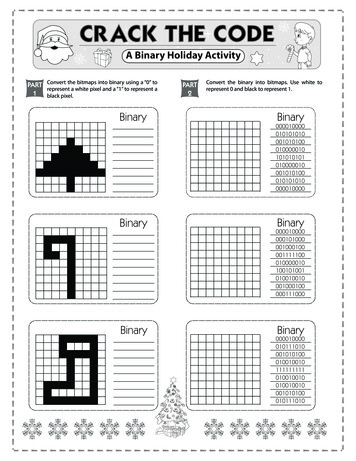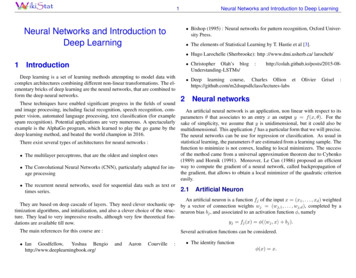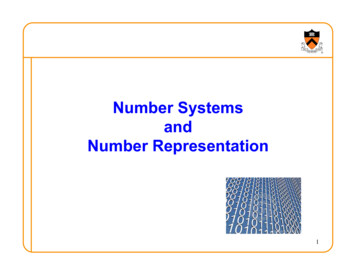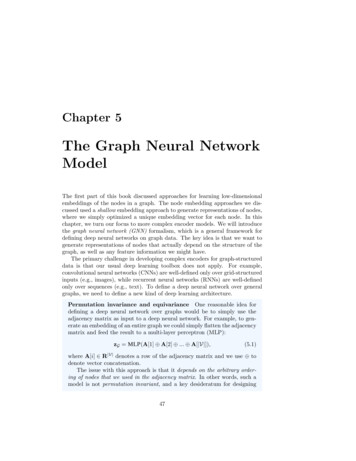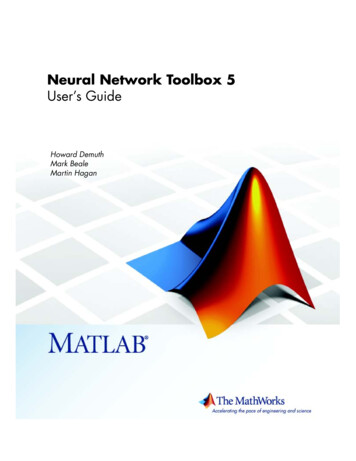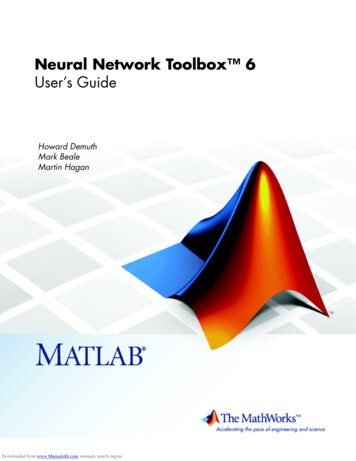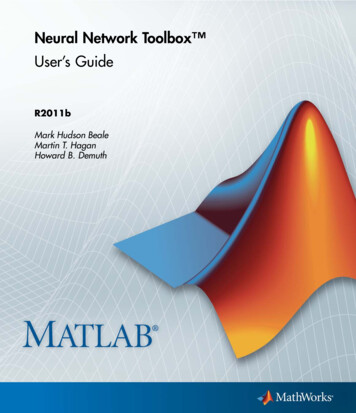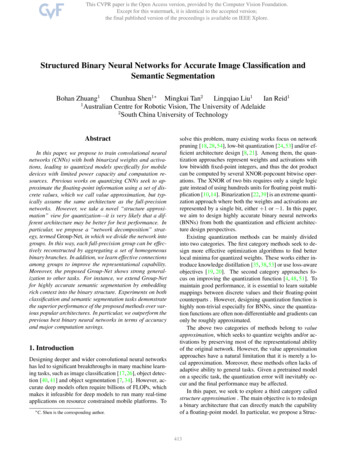
Transcription
Structured Binary Neural Networks for Accurate Image Classification andSemantic SegmentationBohan Zhuang1Chunhua Shen1 Mingkui Tan2Lingqiao Liu1Ian Reid11Australian Centre for Robotic Vision, The University of Adelaide2South China University of TechnologyAbstractIn this paper, we propose to train convolutional neuralnetworks (CNNs) with both binarized weights and activations, leading to quantized models specifically for mobiledevices with limited power capacity and computation resources. Previous works on quantizing CNNs seek to approximate the floating-point information using a set of discrete values, which we call value approximation, but typically assume the same architecture as the full-precisionnetworks. However, we take a novel “structure approximation” view for quantization—it is very likely that a different architecture may be better for best performance. Inparticular, we propose a “network decomposition” strategy, termed Group-Net, in which we divide the network intogroups. In this way, each full-precision group can be effectively reconstructed by aggregating a set of homogeneousbinary branches. In addition, we learn effective connectionsamong groups to improve the representational capability.Moreover, the proposed Group-Net shows strong generalization to other tasks. For instance, we extend Group-Netfor highly accurate semantic segmentation by embeddingrich context into the binary structure. Experiments on bothclassification and semantic segmentation tasks demonstratethe superior performance of the proposed methods over various popular architectures. In particular, we outperform theprevious best binary neural networks in terms of accuracyand major computation savings.1. IntroductionDesigning deeper and wider convolutional neural networkshas led to significant breakthroughs in many machine learning tasks, such as image classification [17,26], object detection [40, 41] and object segmentation [7, 34]. However, accurate deep models often require billions of FLOPs, whichmakes it infeasible for deep models to run many real-timeapplications on resource constrained mobile platforms. To C.Shen is the corresponding author.solve this problem, many existing works focus on networkpruning [18, 28, 54], low-bit quantization [24, 53] and/or efficient architecture design [8, 21]. Among them, the quantization approaches represent weights and activations withlow bitwidth fixed-point integers, and thus the dot productcan be computed by several XNOR-popcount bitwise operations. The XNOR of two bits requires only a single logicgate instead of using hundreds units for floating point multiplication [10,14]. Binarization [22,39] is an extreme quantization approach where both the weights and activations arerepresented by a single bit, either 1 or 1. In this paper,we aim to design highly accurate binary neural networks(BNNs) from both the quantization and efficient architecture design perspectives.Existing quantization methods can be mainly dividedinto two categories. The first category methods seek to design more effective optimization algorithms to find betterlocal minima for quantized weights. These works either introduce knowledge distillation [35,38,53] or use loss-awareobjectives [19, 20]. The second category approaches focus on improving the quantization function [4, 48, 51]. Tomaintain good performance, it is essential to learn suitablemappings between discrete values and their floating-pointcounterparts . However, designing quantization function ishighly non-trivial especially for BNNs, since the quantization functions are often non-differentiable and gradients canonly be roughly approximated.The above two categories of methods belong to valueapproximation, which seeks to quantize weights and/or activations by preserving most of the representational abilityof the original network. However, the value approximationapproaches have a natural limitation that it is merely a local approximation. Moreover, these methods often lacks ofadaptive ability to general tasks. Given a pretrained modelon a specific task, the quantization error will inevitably occur and the final performance may be affected.In this paper, we seek to explore a third category calledstructure approximation . The main objective is to redesigna binary architecture that can directly match the capabilityof a floating-point model. In particular, we propose a Struc-413
tured Binary Neural Network called Group-Net to partitionthe full-precision model into groups and use a set of parallel binary bases to approximate its floating-point structurecounterpart. In this way, higher-level structural informationcan be better preserved than the value approximation approaches.Furthermore, relying on the proposed structured model,we are able to design flexible binary structures accordingto different tasks and exploit task-specific information orstructures to compensate the quantization loss and facilitatetraining. For example, when transferring Group-Net fromimage classification to semantic segmentation, we are motivated by the structure of Atrous Spatial Pyramid Pooling(ASPP) [5]. In DeepLab v3 [6] and v3 [7], ASPP is merelyapplied on the top of extracted features while each block inthe backbone network can employ one atrous rate only. Incontrast, we propose to directly apply different atrous rateson parallel binary bases in the backbone network, whichis equivalent to absorbing ASPP into the feature extractionstage. Thus, we significantly boost the performance on semantic segmentation, without increasing the computationcomplexity of the binary convolutions.In general, it is nontrivial to extend previous value approximation based quantization approaches to more challenging tasks such as semantic segmentation (or other general computer vision tasks). However, as will be shown, ourGroup-Net can be easily extended to other tasks. Nevertheless, it is worth mentioning that value and structure approximation are complementary rather than contradictory.In other words, both are important and should be exploitedto obtain highly accurate BNNs.Our methods are also motivated by those energy-efficientarchitecture design approaches [8, 21, 23, 49] which seek toreplace the traditional expensive convolution with computational efficient convolutional operations (i.e., depthwiseseparable convolution, 1 1 convolution). Nevertheless,we propose to design binary network architectures for dedicated hardware from the quantization view. We highlightthat while most existing quantization works focus on directly quantizing the full-precision architecture, at this pointin time we do begin to explore alternative architectures thatshall be better suited for dealing with binary weights and activations. In particular, apart from decomposing each groupinto several binary bases, we also propose to learn the connections between each group by introducing a fusion gate.Moreover, Group-Net can be possibly further improvedwith Neural Architecture Search methods [37, 55, 56] .Our contributions are summarized as follows: We propose to design accurate BNNs structures fromthe structure approximation perspective. Specifically,we divide the networks into groups and approximateeach group using a set of binary bases. We also propose to automatically learn the decomposition by in-troducing soft connections. The proposed Group-Net has strong flexibility and canbe easily extended to other tasks. For instance, inthis paper we propose Binary Parallel Atrous Convolution (BPAC), which embeds rich multi-scale context into BNNs for accurate semantic segmentation.Group-Net with BPAC significantly improves the performance while maintaining the complexity comparedto employ Group-Net only. We evaluate our models on ImageNet and PASCALVOC datasets based on ResNet. Extensive experiments show the proposed Group-Net achieves thestate-of-the-art trade-off between accuracy and computational complexity.We review some relevant works in the sequel.Network quantization: The recent increasing demand forimplementing fixed point deep neural networks on embedded devices motivates the study of network quantization.Fixed-point approaches that use low-bitwidth discrete values to approximate real ones have been extensively exploredin the literature [4, 22, 29, 39, 51, 53]. BNNs [22, 39] propose to constrain both weights and activations to binary values (i.e., 1 and 1), where the multiply-accumulationscan be replaced by purely xnor(·) and popcount(·) operations. To make a trade-off between accuracy and complexity, [13, 15, 27, 47] propose to recursively perform residualquantization and yield a series of binary tensors with decreasing magnitude scales. However, multiple binarizationsare sequential process which cannot be paralleled. In [29],Lin et al. propose to use a linear combination of binarybases to approximate the floating point tensor during forward propagation. This inspires aspects of our approach,but unlike all of these local tensor approximations, we additionally directly design BNNs from a structure approximation perspective.Efficient architecture design: There has been a rising interest in designing efficient architecture in the recent literature. Efficient model designs like GoogLeNet [45] andSqueezeNet [23] propose to replace 3 3 convolutional kernels with 1 1 size to reduce the complexity while increasing the depth and accuracy. Additionally, separableconvolutions are also proved to be effective in Inceptionapproaches [44, 46]. This idea is further generalized asdepthwise separable convolutions by Xception [8], MobileNet [21, 43] and ShuffleNet [49] to generate energyefficient network structure. To avoid handcrafted heuristics,neural architecture search [30, 31, 37, 55, 56] has been explored for automatic model design.2. MethodMost previous literature has focused on value approximation by designing accurate binarization functions for414
weights and activations (e.g., multiple binarizations [13, 15,27, 29, 47]). In this paper, we seek to binarize both weightsand activations of CNNs from a “structure approximation”view. In the following, we first give the problem definitionand some basics about binarization in Sec. 2.1. Then, inSec. 2.2, we explain our binary architecture design strategy.Finally, in Sec. 2.3, we describe how to utilize task-specificattributes to generalize our approach to semantic segmentation.2.1. Problem definitionFor a convolutional layer, we define the input x Rcin win hin , weight filter w Rc w h and the outputy Rcout wout hout , respectively.Binarization of weights: Following [39], we approximatethe floating-point weight w by a binary weight filter bw anda scaling factor α R such that w αbw , where bw isthe sign of w and α calculates the mean of absolute valuesof w. In general, sign(·) is non-differentiable and so weadopt the straight-through estimator [1] (STE) to approximate the gradient calculation. Formally, the forward andbackward processes can be given as follows:Forward : bw sign(w),(1) ℓ ℓ bw ℓBackward : ·,ww w b w bwhere ℓ is the loss.Binarization of activations: For activation binarization,we utilize the piecewise polynomial function to approximate the sign function as in [33]. The forward and backward can be written as:Forward : ba sign(x), ℓ ba ℓ bBackward : xa · x , (2) 2 2x : 1 x 0a2 2x:0 x 1 .where b x 0 : otherwise2.2. Structured Binary Network DecompositionIn this paper, we seek to design a new structural representation of a network for quantization. First of all, note that afloat number in computer is represented by a fixed-numberof binary digits. Motivated by this, rather than directly doing the quantization via “value decomposition”, we proposeto decompose a network into binary structures while preserving its representability.Specifically, given a floating-point residual network Φwith N blocks, we decompose Φ into P binary fragments[F1 , ., FP ], where Fi (·) can be any binary structure. Notethat each Fi (·) can be different. A natural question arises:can we find some simple methods to decompose the network with binary structures so that the representability canbe exactly preserved? To answer this question, we here explore two kinds of architectures for F(·), namely layer-wisedecomposition and group-wise decomposition in Sec. 2.2.1and Sec. 2.2.2, respectively. After that, we will present anovel strategy for automatic decomposition in Sec. 2.2.3.2.2.1Layer-wise binary decompositionThe key challenge of binary decomposition is how to reconstruct or approximate the floating-point structure. Thesimplest way is to approximate in a layer-wise manner. LetB(·) be a binary convolutional layer and bwi be the binarized weights for the i-th base. In Fig. 1 (c), we illustrate thelayer-wise feature reconstruction for a single block. Specifically, for each layer, we aim to fit the full-precision structureusing a set of binarized homogeneous branches F(·) givena floating-point input tensor x:KKXXF(x) λi (bw(3)λi Bi (x) i sign(x)),i 1i 1where is bitwise operations xnor(·) and popcount(·), Kis the number of branches and λi is the combination coefficient to be determined. During the training, the structure is fixed and each binary convolutional kernel bwi aswell as λi are directly updated with end-to-end optimization. The scale scalar can be absorbed into batch normalization when doing inference. Note that all Bi ’s in Eq. (3)have the same topology as the original floating-point counterpart. Each binary branch gives a rough approximationand all the approximations are aggregated to achieve moreaccurate reconstruction to the original full precision convolutional layer. Note that when K 1, it corresponds to directly binarize the floating-point convolutional layer (Fig. 1(b)). However, with more branches (a larger K), we are expected to achieve more accurate approximation with morecomplex transformations.During the inference, the homogeneous K bases can beparallelizable and thus the structure is hardware friendly.This will bring significant gain in speed-up of the inference.Specifically, the bitwise XNOR operation and bit-countingcan be performed in a parallel of 64 by the current generation of CPUs [33, 39]. And we just need to calculate Kbinary convolutions and K full-precision additions. As aresult, the speed-up ratio σ for a convolutional layer can becalculated as:cin cout whwin hin,σ 164 (Kcin cout whwin hin ) Kcout wout hout(4)64cin whwin hin .·K cin whwin hin 64wout houtWe take one layer in ResNet for example. If we set cin 256, w h 3 3, win hin wout hout 28,K 5, then it can reach 12.45 speedup. But in practice,each branch can be implemented in parallel. And the actualspeedup ratio is also influenced by the process of memoryread and thread communication.415
ℱ ( )B( )B( )B( ) B( ) conv conv B( )B( )(a)(b)λ1 λK(c)Figure 1: Overview of the baseline binarization method and the proposed layer-wise binary decomposition. We take one residual block with two convolutional layers for illustration. For convenience, we omit batch normalization and nonlinearities. (a): The floating-point residual block. (b): Directbinarization of a full-precision block. (c): Layer-wise binary decomposition in Eq. (3), where we use a set of binary convolutional layers B(·) to approximate a floating-point convolutional layer.(a)conv convconvconvset Gi (·) as the basic residual block [17] which is shownin Fig. 2 (a). Considering the residual architecture, we candecompose F(x) by extending Eq. (3) as: G( )B( )B( )B( ) λ1λKB( )B( ) λKH ( )B( )B( ) B( )B( ) B( )B( )B( )B( ) λ1 λK (c)Figure 2: Illustration of the proposed group-wise binary decompositionstrategy. We take two residual blocks for description. (a): The floatingpoint residual blocks. (b): Basic group-wise binary decomposition inEq. (5), where we approximate a whole block with a linear combinationof binary blocks G(·). (c): We approximate a whole group with homogeneous binary bases H(·), where each group consists of several blocks.This corresponds to Eq. (6).2.2.2Group-wise binary decompositionIn the layer-wise approach, we approximate each layer withmultiple branches of binary layers. Note each branch willintroduce a certain amount of error and the error may accumulate due to the aggregation of multi-branches. As a result, this strategy may incur severe quantization errors andbring large deviation for gradients during backpropagation.To alleviate the above issue, we further propose a more flexible decomposition strategy called group-wise binary decomposition, to preserve more structural information duringapproximation.To explore the group-structure decomposition, we firstconsider a simple case where each group consists of onlyone block. Then, the layer-wise approximation strategy canbe easily extended to the group-wise case. As shown inFig. 2 (b), similar to the layer-wise case, each floating-pointgroup is decomposed into multiple binary groups. However, each group Gi (·) is a binary block which consists ofseveral binary convolutions and floating-point element-wiseoperations (i.e., ReLU, AddTensor). For example, we canKXλi Gi (x),(5)i 1 B( )B( )B( )λ1 (b) F(x) where λi is the combination coefficient to be learned. InEq. (5), we use a linear combination of homogeneous binary bases to approximate one group, where each base Giis a binarized block. In this way, we effectively keep theoriginal residual structure in each base to preserve the network capacity. As shown in Sec. 4.3.1, the group-wise decomposition strategy performs much better than the simplelayer-wise approximation.Furthermore, the group-wise approximation is flexible.We now analyze the case where each group may containdifferent number of blocks. Suppose we partition the network into P groups and it follows a simple rule that eachgroup must include one or multiple complete residual building blocks. For the p-th group, we consider the blocks setT {Tp 1 1, ., Tp }, where the index Tp 1 0 if p 1.And we can extend Eq. (5) into multiple blocks format:KPF(xTp 1 1 ) λi Hi (x),i 1(6)KPTT 1T 1 λi Gi p (Gi p (.(Gi p 1 (xTp 1 1 )).)),i 1where H(·) is a cascade of consequent blocks which isshown in Fig. 2 (c). Based on F(·), we can efficiently construct a network by stacking these groups and each groupmay consist of one or multiple blocks. Different fromEq. (5), we further expose a new dimension on each base,which is the number of blocks. This greatly increases thestructure space and the flexibility of decomposition. We illustrate several possible connections in Sec. S1 in the supplementary file and further describe how to learn the decomposition in Sec. 2.2.3.2.2.3Learning for dynamic decompositionThere is a big challenge involved in Eq. (6). Note that thenetwork has N blocks and the possible number of connections is 2N . Clearly, it is not practical to enumerate all possible structures during the training. Here, we propose to416
(a): The conventional floating-point dilated convolution.solve this problem by learning the structures for decomposition dynamically. We introduce in a fusion gate as the softconnection between blocks G(·). To this end, we first definethe input of the i-th branch for the n-th block as:Cin sigmoid(θin ),xni Cin Gin 1 (xn 1)i (1 Cin ) KXFloating-point feature mapa11B( )B( ) 3x3 Conv, dilation rate a65a66a67a71a72a73a74a75a76a77 w11w12w13w21w22w23w31w32w33OutputMulti-dilations decompose-1 1 -1Binary feature map-1B( ) B( ) λKB( )λ11-1111-11-1 -1-1111-111-11-11-11111-1 -11-11-1 -111-1 -1 -1-1-11-1111 1 -1 1-1 1 -1-1-1 -1 B( ) 13x3 Convrate 1Output-1-1-1Sum 1-1-1 3x3 Conv1-11rate 2 .B( )a16SignG1nC1 B( ) a15j 1 λ1a14λj Gjn 1 (xjn 1 ),Fusion gate1 C1a13(7)where θ RK is a learnable parameter vector, Cin is a gatescalar and is the Hadamard product.G1n 1a12λK(b): The proposed Binary Parallel Atrous Convolution (BPAC).Figure 3: Illustration of the soft connection between two neighbouringblocks. For convenience, we only illustrate the fusion strategy for onebranch.Here, the branch input xni is a weighted combination oftwo paths. The first path is the output of the correspondingi-th branch in the (n 1)-th block, which is a straight connection. The second path is the aggregation output of the(n 1)-th block. The detailed structure is shown in Fig. 3.In this way, we make more information flow into the branchand increase the gradient paths for improving the convergence of BNNs.Remarks: For the extreme case whenKPCin 0,i 1Eq. (7) will be reduced to Eq. (5) which means we approximate the (n 1)-th and the n-th block independently. WhenKPCin K , Eq. (7) is equivalent to Eq. (6) and we set H(·)i 1to be two consequent blocks and approximate the group asa whole. Interestingly, whenKN PPCin N K , it corre-n 1 i 1sponds to set H(·) in Eq. (6) to be a whole network anddirectly ensemble K binary models.2.3. Extension to semantic segmentationThe key message conveyed in the proposed method is thatalthough each binary branch has a limited modeling capability, aggregating them together leads to a powerful model.In this section, we show that this principle can be appliedto tasks other than image classification. In particular, weconsider semantic segmentation which can be deemed as adense pixel-wise classification problem. In the state-of-theart semantic segmentation network, the atrous convolutionallayer [6] is an important building block, which performsconvolution with a certain dilation rate. To directly applyFigure 4: The comparison between conventional dilated convolution andBPAC. For expression convenience, the group only has one convolutionallayer. is the convolution operation and indicates the XNOR-popcountoperations. (a): The original floating-point dilated convolution. (b): Wedecompose the floating-point atrous convolution into a combination of binary bases, where each base uses a different dilated rate. We sum theoutput features of each binary branch as the final representation.the proposed method to such a layer, one can construct multiple binary atrous convolutional branches with the samestructure and aggregate results from them. However, wechoose not to do this but propose an alternative strategy: weuse different dilation rates for each branch. In this way, themodel can leverage multiscale information as a by-productof the network branch decomposition. It should be notedthat this scheme does not incur any additional model parameters and computational complexity compared with thenaive binary branch decomposition. The idea is illustratedin Fig. 4 and we call this strategy Binary Parallel AtrousConvolution (BPAC).In this paper, we use the same ResNet backbone in [6,7] with output stride 8, where the last two blocks employ atrous convolution. In BPAC, we keep rates {2, 3, ., K, K 1} and rates {6, 7, ., K 4, K 5} forK bases in the last two blocks, respectively. Intriguingly, aswill be shown in Sec. 4.4, our strategy brings so much benefit that using five binary bases with BPAC achieves similarperformance as the original full precision network despitethe fact that it saves considerable computational cost.3. DiscussionsComplexity analysis: A comprehensive comparison of various quantization approaches over complexity and storageis shown in Table 1. For example, in the previous state-417
Table 1: Computational complexity and storage comparison of different quantization approaches. F : full-precision, B: binary, QK : K-bit quantization.ModelFull-precision DNN[22, 39][9, 20][50, 52][35, 48, 51, 53][13, 15, 27, 29, 47]Group-NetWeights ActivationsFFBBBFQKFQKQKK BK BK (B, B)Operations , -, XNOR-popcount , , -, , -, , -, XNOR-popcount , -, XNOR-popcountof-the-art binary model ABC-Net [29], each convolutionallayer is approximated using K weight bases and K activation bases, which needs to calculate K 2 times binary convolution. In contrast, we just need to approximate severalgroups with K structural bases. As reported in Sec. 4.2 , wesave approximate K times computational complexity whilestill achieving comparable Top-1 accuracy. Since we use Kstructural bases, the number of parameters increases by Ktimes in comparison to the full-precision counterpart. Butwe still save memory bandwidth by 32/K times since allthe weights are binary in our paper. For our approach, thereexists element-wise operations between each group, so thecomputational complexity saving is slightly less than 64K .Differences of Group-net from fixed-point methods: Theproposed Group-net with K bases is different from the Kbit fixed-point approaches [35, 48, 51, 53].We first show how the inner product between fixed-pointweights and activations can be computed by bitwise operations. Let a weight vector w RM be encoded by a vectorMbwi { 1, 1} , i 1, ., K. Assume we also quantize activations to K-bit. Similarly, the activations x canbe encoded by baj { 1, 1}M , j 1, ., K. Then, theconvolution can be written asQK (wT )QK (x) K 1X K 1Xi 0 j 0a2i j (bwi bj ),(8)1where QK (·) is any quantization function .During the inference, it needs to first get the encoding baj for each bit by looking up the quantization intervals. Then, it calculates and sums over K 2 timesxnor(·) and popcount(·). The complexity is about O(K 2 ).Note that the output range for a single output shall be[ (2K 1)2 M, (2K 1)2 M ].In contract, we directly obtain baj via sign(x). Moreover, since we just need to calculate K times xnor(·) andpopcount(·) (see Eq. (3)), and then sum over the outputs,the computational complexity is O(K). For binary convolution, its output range is {-1, 1}. So the value range foreach element after summation is [ KM, KM ], in whichthe number of distinct values is much less than that in fixedpoint methods.1 Forsimplicity, we only consider uniform quantization in this paper.Memory saving1 32 32 32K 32K 32K 32K Computation Saving1 64 2 2 64 K2 64 K2 64K In summary, compared with K-bit fixed-pointmeth ods, Group-Net with K bases just needs K compuK2tational complexity and saves (2 1) /K accumulatorbandwidth. Even K-bit fixed-point quantization requiresmore memory bandwidth to feed signal in SRAM or in registers.Differences of Group-net from multiple binarizationsmethods: In ABC-Net [29], a linear combination ofbinary weight/activations bases are obtained from thefull-precision weights/activations without being directlylearned. In contrast, we directly design the binary networkstructure, where binary weights are end-to-end optimized.[13,15,27,47] propose to recursively approximate the residual error and obtain a series of binary maps correspondingto different quantization scales. However, it is a sequentialprocess which cannot be paralleled. And all multiple binarizations methods belong to local tensor approximation. Incontrast to value approximation, we propose a structure approximation approach to mimic the full-precision network.Moreover, tensor-based methods are tightly designed to local value approximation and are hardly generalized to othertasks accordingly. In addition, our structure decompositionstrategy achieves much better performance than tensor-levelapproximation as shown in Sec. 4.3.1. More discussions areprovided in Sec. S2 in the supplementary file.4. ExperimentWe define several methods for comparison as follows:LBD: It implements the layer-wise binary decompositionstrategy described in Sec. 2.2.1. Group-Net: It implements the full model with learnt soft connections describedin Sec. 2.2.3. Following Bi-Real Net [32, 33], we applyshortcut bypassing every binary convolution to improve theconvergence. Group-Net**: Based on Group-Net, we keepthe 1 1 downsampling convolution to full-precision similar to [2, 33].4.1. Implementation detailsAs in [4, 39, 51, 53], we quantize the weights and activations of all convolutional layers except that the first and thelast layer have full-precision. In all ImageNet experiments,training images are resized to 256 256, and a 224 224crop is randomly sampled from an image or its horizontal418
flip, with the per-pixel mean subtracted. We do not use anyfurther data augmentation in our implementation. We use asimple single-crop testing for standard evaluation. No biasterm is utilized. We first pretrain the full-precision modelas initialization with Tanh(·) as nonlinearity and fine-tunethe binary counterpart. We use Adam [25] for optimization. For training all binary networks, the mini-batch sizeand weight decay are set to 256 and 0, respectively. Thelearning rate starts at 5e-4 and is decayed twice by multiplying 0.1 at the 30th and 40th epoch. We train 50 epochsin total. Following [4, 53], no dropout is used due to binarization itself can be treated as a regularization. We applylayer-reordering to the networks as: Sign Conv ReLU BN. Inserting ReLU(·) after convolution is important forconvergence. Our simulation implementation is based onPytorch [36].4.2. Evaluation on ImageNetThe proposed method is evaluated on ImageNet(ILSVRC2012) [42] dataset.ImageNet is a largescale dataset which has 1.2M training images from 1Kcategories and 50K validation images. Several representative networks are tested: ResNet-18 [17], ResNet-34 andResNet-50. As discussed in Sec. 3, binary approachesand fixed-point approaches differ a lot in computationalcomplexity as well as storage consumption. So we comparethe proposed approach with binary neural networks inTable 2 and fixed-point approaches in Table 3, respectively.4.2.1 Comparison with binary neural networksSince we employ binary weights and binary activations, wedirectly compare to the previous state-of-the-art binary approaches, including BNN [22], XNOR-Net [39], Bi-RealNet [33] and ABC-Net [29]. We report the results in Table 2 and summarize the following points. 1): The mostcomparable baseline for Group-Ne
novel strategy for automatic decomposition in Sec. 2.2.3. 2.2.1 Layer-wise binary decomposition The key challenge of binary decomposition is how to re-construct or approximate the floating-point structure. The simplest way is to approximate in a layer-wise manner. Let B(·) be a binary convolutional layer and bw i be the bina .
